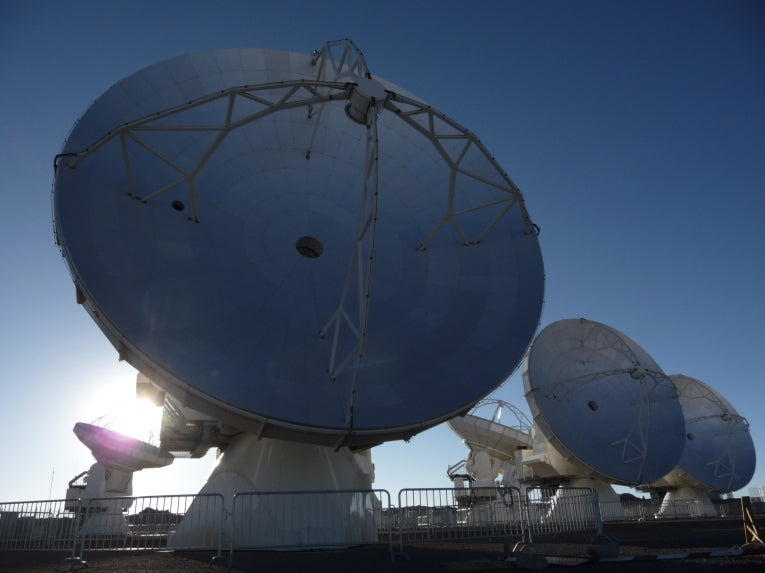View from the center of the Atacama Large Millimeter/submillimeter Array at an elevation of 16,500 feet on the Chajnantor Plain in northern Chile. Each of these radio telescopes has a dish spanning nearly 40 feet across. Credit: Tania Burchell, NRAO/AUI/NSF
Offering unprecedented sensitivity and resolution, the Atacama Large Millimeter/submillimeter Array (ALMA) is almost ready for its closeup. Although not yet complete, the massive radio telescope complex under construction high in Chile's Atacama desert is already providing breathtaking images of celestial phenomena. This week the National Radio Astronomy Observatory (NRAO) released images of stars forming amid the mayhem created by the collision of two distant galaxies.
Described as "the largest leap in telescope technology since Galileo first aimed a lens on the Universe," the ambitious array collects information with far greater detail than ever before, in a portion of the invisible spectrum, effectively painting remarkably detailed portraits of incredibly faint distant celestial phenomena. ALMA is a cooperative effort by the U.S., Europe, Japan and Chile.

The Antennae Galaxies (also known as NGC 4038 and 4039) are a pair of distorted colliding spiral galaxies about 70 million light-years away, in the constellation of Corvus (The Crow). This view combines ALMA observations, made in two different wavelength ranges during the observatory's early testing phase, with visible-light observations from the NASA/ESA Hubble Space Telescope; Credit: ALMA (ESO/NAOJ/NRAO). Visible light image: the NASA/ESA Hubble Space Telescope
To celebrate the launch of the new facility, NRAO released the image of two distant galaxies caught in the process of violently crashing together in real time (albeit on an astronomical time scale). As impressive as the sight is, it's only a hint of what's to come, said researchers. "We chose the impressive interacting system called the Antennae galaxies as a test subject," said Dr. Alison Peck, an astronomer from NRAO serving in Chile during ALMA's years of careful construction and rigorous testing, "because it is in the process of undergoing the type of spectacular, violent merger that many galaxies may have undergone since their formation, but that we can rarely catch in action."
Within two more years, ALMA will have more than tripled the number of telescopes in the array, to 66. A unique supercomputer links dozens of widespread telescopes, combining their data to form a single virtual telescope of unprecedented capabilities. "ALMA's test views of the Antennae show us star-forming regions on a level of detail that no other telescope on Earth or in space has attained," said Dr. Mark McKinnon, North American ALMA Project Manager from the NRAO in Charlottesville, Virginia. "This capability can only get much better as ALMA nears completion." The spiral Antennae galaxies began their slow-motion collision about six hundred million years ago, making them the youngest - and nearest - pair of colliding galaxies ever discovered.










